50 Kiat dan Praktik Terbaik Manajemen Fasilitas Ahli
Apakah Anda seorang manajer fasilitas terkenal dan berpengalaman atau hanya seorang calon, kita semua tahu bahwa ini adalah pekerjaan yang membutuhkan pendidikan lanjutan dan banyak nasihat bijak, terutama dalam hal penerapan teknologi baru.
Beruntung bagi Anda, kami telah mengumpulkan 50 tips dan praktik terbaik yang paling bermanfaat dan dapat diterapkan dari para pemikir terhebat dalam manajemen fasilitas hari ini. Luangkan waktu untuk membaca dengan teliti tips dan trik ini sehingga Anda juga dapat melakukan apa yang Anda butuhkan untuk membuat fasilitas Anda semodern dan seaman mungkin.
Kami telah mengatur praktik terbaik berdasarkan bagian. Klik tautan di bawah untuk langsung menuju ke kiat yang paling Anda butuhkan.
- Kiat Untuk Menurunkan Biaya Operasi
- Tips Perawatan Pencegahan
- Tips Manajemen dan Komunikasi Tenaga Kerja
- Kiat untuk Memanfaatkan Teknologi, Alat, Perangkat Lunak, dan Metrik
- Tips Manajemen Inventaris dan Aset
Kiat untuk Menurunkan Biaya Operasi
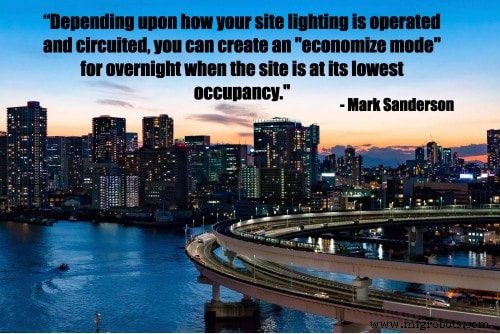
1. Potong pencahayaan situs malam hari. “Bergantung pada bagaimana pencahayaan situs Anda dioperasikan dan disirkulasikan, Anda dapat membuat 'mode hemat' untuk bermalam saat situs berada pada tingkat hunian terendah. Pertahankan pencahayaan situs perimeter di sekitar properti Anda dan semua pintu masuk dan drive utama menyala.
“Anda perlu memastikan bahwa penerangan di dekat gedung dan semua pintu masuk dan keluar akan tetap menyala bersama dengan jalur penerangan perlengkapan darurat. Cari pencahayaan situs di antara zona-zona ini dan buat akomodasi di pengontrol otomatisasi pencahayaan Anda agar dapat mematikan zona atau sirkuit yang paling sedikit digunakan.”— Mark Sanderson, seperti dikutip oleh Brandon Lorenz, Sepuluh Tips Untuk Manajer Fasilitas Untuk Memotong Biaya Energi, FasilitasNet
2. Ganti pencahayaan lama dengan LED. “ Pusat Kanker Memorial Sloan-Kettering memilih LED untuk menggantikan pencahayaan yang ada di garasi parkir yang buka 24/7, mengurangi separuh konsumsi daya garasi. Sementara itu, Sekolah Komunitas Mediapolis di Mediapolis, IA, juga memulai retrofit pencahayaan eksterior LED.
“Sebagian besar lampu lama kami memiliki daya 250 atau 175 watt. Itu diganti dengan LED 30 watt. Lampu 70 watt kami diganti dengan LED 20 watt dan lampu kaleng 70 watt kami diganti dengan LED 10 watt. Kami akan mendapatkan potongan harga yang bagus dari perusahaan listrik kami, ditambah penghematan bulanan untuk tagihan listrik kami.”–Dennis Breuer, seperti dikutip oleh Janelle Penny, 12 Strategi Teratas untuk Memaksimalkan Penghematan Biaya, Majalah Bangunan; Twitter:@BuildingsMedia
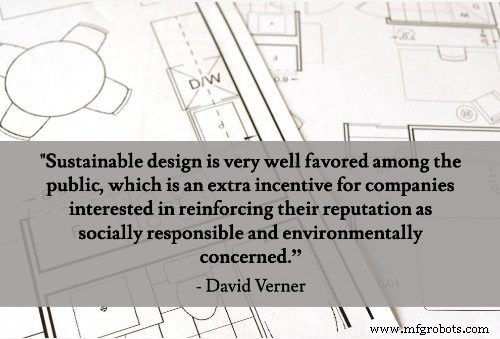
3. Menerapkan rencana desain fasilitas yang berkelanjutan. “Desain berkelanjutan lebih dapat dicapai dan terjangkau daripada sebelumnya, terutama jika Anda berpikir dalam hitungan tahun, bukan hari dan minggu. Perlu juga dicatat bahwa desain berkelanjutan sangat disukai masyarakat, yang merupakan insentif tambahan bagi perusahaan yang tertarik untuk memperkuat reputasi mereka sebagai perusahaan yang bertanggung jawab secara sosial dan peduli lingkungan.”–David Verner, Mengurangi Biaya Fasilitas Industri dengan Perencanaan Berkelanjutan, Pengembangan Wilayah; Twitter:@areaDevelopment
4. Mengetahui total biaya dari semua pekerjaan fasilitas yang dilakukan baik secara langsung maupun tidak langsung. “Bagi mata yang tidak terlatih, unit pemeliharaan fasilitas bisnis tampaknya merupakan lubang hitam biaya. Biaya layanan FM ini bertambah, dan kecuali perbedaan muncul, di situlah sebagian besar analisis bisnis berakhir. Namun, manajer pemeliharaan fasilitas, yang mengetahui semua nuansa yang membentuk setiap perintah kerja, memahami kompleksitas dan overhead yang terlibat dalam sektor bisnis ini.
“Ada banyak variabel yang mempengaruhi total biaya setiap layanan seperti biaya perjalanan dan material, selain biaya operasional langsung dan tidak langsung lainnya yang terkait dengan manajemen fasilitas.”–Sean Hartnett, Cara Menghitung Biaya Pemeliharaan Fasilitas yang Sebenarnya , Bantuan SMS; Twitter:@SMSAssistLLC
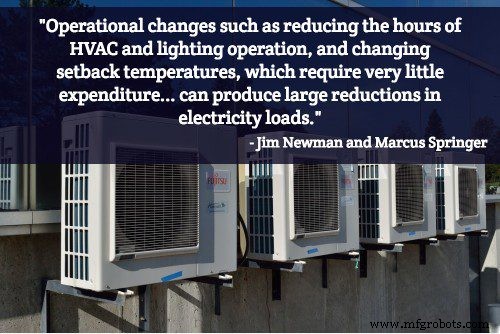
5. Pertimbangkan perbaikan yang kurang jelas yang berdampak pada penggunaan energi fasilitas. “Beberapa proyek terkait energi akan lebih atau kurang tersembunyi dari pengguna dan terutama dilakukan untuk mengurangi permintaan energi, seperti peningkatan pendingin dan unit kipas. Proyek-proyek semacam itu mungkin pada akhirnya memberikan kontrol suhu yang lebih baik kepada pengguna gedung, tetapi ini bukan tujuan utama peningkatan.
“Perubahan operasional seperti mengurangi jam pengoperasian HVAC dan pencahayaan, dan mengubah suhu penurunan, yang memerlukan pengeluaran yang sangat sedikit (jika ada sama sekali) tidak secara langsung mempengaruhi pengalaman pengguna, tetapi dapat menghasilkan pengurangan besar dalam beban listrik. Secara umum, bekerja dengan tim operasi gedung untuk mengurangi penggunaan energi dapat menghasilkan pengurangan beban yang mengesankan.”–Jim Newman dan Marcus Springer, Jadilah Pahlawan Dengan Biaya Operasi Lebih Rendah di Gedung Anda , FMLink; Twitter:@FMLinkGroupLLC
6. Jangan lupa untuk melihat insulasi bangunan Anda. “Semua bangunan komersial diisolasi; kode bangunan mewajibkan untuk mengisolasi hingga tingkat tertentu. Sayangnya, karena sebagian besar bangunan dipasang di bawah panduan ketat anggaran, mereka biasanya dipasang hanya dengan sedikit isolasi. Dan karena perusahaan yang mendirikan gedung jarang yang mengelola atau memilikinya, keduanya memiliki sudut pandang yang sangat berbeda mengenai anggaran.
“Insulasi yang lebih tinggi berarti efisiensi yang lebih baik. Bila memungkinkan, Anda dapat meningkatkan tingkat insulasi dan membuat perbedaan langsung dalam tingkat kenyamanan keseluruhan penghuni bangunan. Langkah-langkah umum termasuk memasang jendela dan sistem pencahayaan yang hemat energi, dan memperbaiki atap untuk meminimalkan dampak matahari pada bangunan itu sendiri.”—Kiat untuk Mengurangi Biaya Pemanasan dan Pendinginan Komersial, Layanan Sistem Total
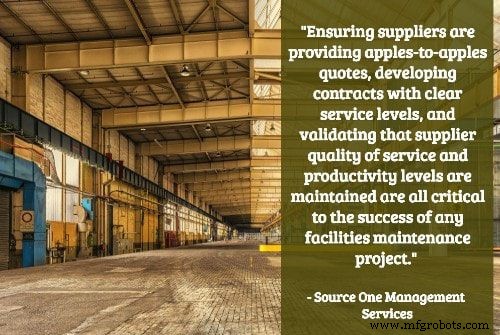
7. Memanfaatkan pendekatan sumber strategis untuk menemukan pemasok yang tepat untuk pekerjaan fasilitas. “Menemukan pemasok yang tepat untuk memelihara fasilitas Anda bisa jadi sulit dan memakan waktu. Dari layanan kebersihan, hingga persediaan pemeliharaan dan pemeliharaan lahan, memastikan pemasok memberikan penawaran harga yang wajar, mengembangkan kontrak dengan tingkat layanan yang jelas, dan memvalidasi bahwa kualitas layanan dan tingkat produktivitas pemasok dipertahankan, semuanya penting untuk keberhasilan pemeliharaan fasilitas apa pun. proyek.
“Upaya untuk memotong biaya dalam kategori pemeliharaan fasilitas dihalangi oleh ketidakmampuan untuk membahayakan standar keselamatan dan kenyamanan karyawan Anda. Bagi banyak organisasi, hal ini mengakibatkan mereka membayar mahal kepada pemasok pemeliharaan fasilitas mereka.”—Strategi Sumber Strategis Untuk Kategori Pemeliharaan Fasilitas dan Manajemen Fasilitas, Sumber Satu Layanan Manajemen; Twitter:@getsavings
8. Pabrik boiler Anda mungkin menjadi sumber utama potensi peningkatan efisiensi. “Boiler saat ini dapat mencapai efisiensi hingga 96 persen menggunakan teknologi kondensasi; namun, bangunan tipikal, termasuk bangunan baru, menggunakan boiler tipe atmosfer yang, untuk semua maksud dan tujuan, hanya sedikit lebih maju daripada pembakar Bunsen lab sains. Teknologi ini dapat diandalkan dan berfungsi, tetapi mahal untuk dioperasikan. Biasanya, kami melihat teknologi ini dipasang untuk meminimalkan biaya konstruksi dengan sedikit pertimbangan untuk dampak energi jangka panjang yang tersisa untuk diserap oleh anggaran operasional gedung.”–Ross Morley dan Ed Porasz, Enam Kiat Audit Energi untuk Manajer Gedung , Jaringan REMI; Twitter:@REMINetwork
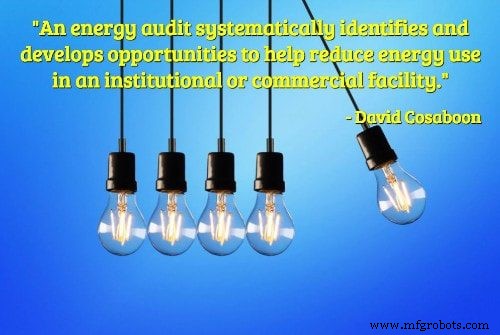
9. Jadwalkan audit energi profesional. “Audit energi secara sistematis mengidentifikasi dan mengembangkan peluang untuk membantu mengurangi penggunaan energi di fasilitas institusional atau komersial dan, sebagai hasilnya, mengurangi biaya operasional gedung. Memfokuskan audit sangat penting bagi manajer pemeliharaan dan teknik.
“Menentukan area dan sistem yang akan disertakan dalam audit sebagian bergantung pada sumber daya yang bersedia diinvestasikan oleh organisasi dalam efisiensi energi, kompleksitas fasilitas, dan jumlah detail dan analisis yang diinginkan dari audit. Memahami faktor-faktor ini akan membantu manajer memilih tingkat audit yang sesuai dengan kebutuhan gedung dan organisasi.”–David Cosaboon, Audit Energi Mana yang Tepat untuk Fasilitas Anda ?, FasilitasNet
10. Identifikasi potensi efisiensi utama dalam penggunaan energi dapur Anda. “Dapur komersial adalah pengguna energi tinggi, mengkonsumsi sekitar 2,5 kali lebih banyak energi per kaki persegi daripada ruang komersial lainnya, menurut Badan Perlindungan Lingkungan AS (EPA). Dari jumlah itu, hanya 40% yang digunakan dalam persiapan dan penyimpanan makanan, kata Carbon Trust dari Inggris; sebagian besar energi yang terbuang dibuang ke dapur.
“Teknologi ini ada untuk pengurangan dramatis dalam konsumsi energi, menghasilkan pengurangan jejak karbon dan penghematan biaya yang signifikan. EPA mengklaim bahwa restoran yang berinvestasi secara strategis dapat memangkas biaya energi antara 10%-30%; Foodservice Consultants Society International (FCSI), organisasi profesional untuk layanan konsultasi desain dan manajemen, memperkirakan penghematan energi dapat mencapai 40%, setara dengan 3%-6% dari biaya operasional.”–Energi Efisiensi di Dapur , Pengusaha Hijau; Twitter:@green_hotelier
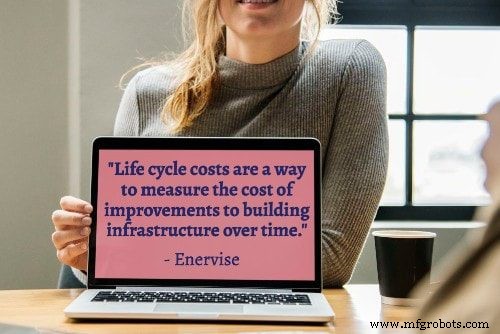
11. Pertimbangkan seluruh biaya siklus hidup sebuah bangunan. “Biaya siklus hidup adalah cara untuk mengukur biaya perbaikan untuk membangun infrastruktur dari waktu ke waktu. Hal ini memungkinkan profesional manajemen gedung dan fasilitas untuk menentukan apakah biaya untuk meningkatkan elemen tertentu dari sebuah bangunan atau sistem di dalamnya terhadap penghematan biaya selama periode yang sama. Jika biaya upgrade selama masa pakainya menawarkan keuntungan dibandingkan biaya operasional gedung yang akan dihemat, maka itu umumnya dianggap sebagai investasi yang baik.”—Jawaban untuk 8 Pertanyaan Umum Biaya Operasi Gedung , Enervis
Kiat Pemeliharaan Pencegahan
12. Ukur PM Anda versus semua aktivitas pemeliharaan. “Kembangkan ukuran kinerja untuk proses PM Anda dengan penekanan pada pengukuran jumlah PM yang diselesaikan dibandingkan dengan semua pekerjaan lainnya. Total jam PM harus menjadi persentase tertinggi dari semua pekerjaan pemeliharaan departemen. Tujuan ini mungkin tampak mustahil, tetapi seiring waktu, itu sangat dapat dicapai.” –Michael Cowley, 5 Tips untuk Pemeliharaan Pencegahan yang Berhasil , FasilitasNet
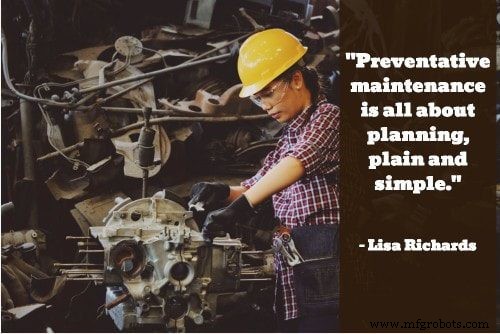
13. Tetapkan rencana dan patuhi itu. “Pemeliharaan preventif adalah tentang perencanaan, sederhana dan sederhana. Setiap peralatan atau mesin yang Anda miliki atau dalam perawatan Anda harus memiliki jadwal jenis perawatan apa yang diperlukan dan kapan pemeriksaan itu diperlukan.
“Mengatur jadwal tidak hanya memastikan bahwa peralatan Anda tetap dalam kondisi prima -bentuk terbaik selama masa pakai yang diproyeksikan, tetapi juga membantu Anda merencanakan kebutuhan staf dan tetap sesuai anggaran. Setelah Anda menyiapkan rencana, jangan pernah menyimpang darinya.”–Lisa Richards, 7 Tips Perawatan Pencegahan untuk Fasilitas Anda , MAPCON; Twitter:@MAPOCONtech
14. Fokus pada model kegagalan tertentu. "Mode kegagalan didefinisikan sebagai "bagaimana sesuatu gagal." Mari kita gunakan atap datar/membran untuk menunjukkan contoh mode kegagalan. Pada atap datar/membran, satu mode kegagalan mungkin "penetrasi membran atap", dan penyebab mode kegagalan ini bisa banyak. Mengetahui mode kegagalan dari item tertentu yang dapat dirawat seperti atap membran dan penyebabnya dapat menjadi kunci untuk deteksi dini kegagalan atap (tidak memenuhi maksud pengguna akhir) sehingga perbaikan dapat dilakukan sebelum mempengaruhi operasi .“–Ricky Smith, Lima Tips Untuk Mengoptimalkan Program Pemeliharaan Pencegahan Fasilitas, Majalah Sistem Rekayasa; Twitter:@esmagazine
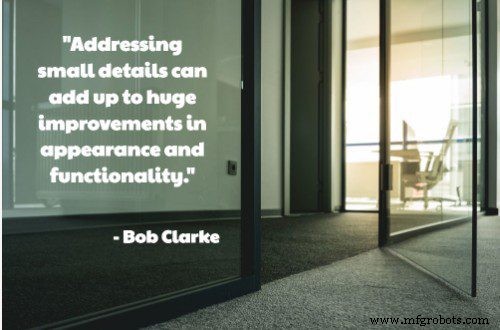
15. Lakukan penelusuran proaktif untuk menemukan masalah "kecil". “Tangkap masalah kecil sekarang sebelum menjadi besar. Mengatasi detail kecil dapat menambahkan hingga peningkatan besar dalam penampilan dan fungsionalitas. Mintalah penyedia layanan fasilitas, perusahaan kebersihan, dan/atau tukang Anda untuk menemani Anda, dengan fokus pada detail yang biasanya Anda abaikan. Beberapa hal yang harus diperiksa untuk perbaikan/penggantian adalah:pintu (sapuan pintu, penahan pintu, kunci yang menempel, dll.), pelindung sudut, ubin dan nat, sakelar lampu dan pelat muka, ubin langit-langit, meja dan rak, lemari dan engsel, dan pemadam api.
“Dan jangan lupa betapa lebih segar segala sesuatunya terlihat dengan dempul baru dan lapisan cat baru di dinding – cuaca yang lebih hangat dapat menjadikan Musim Semi waktu yang tepat untuk memberikan kehidupan estetika baru pada fasilitas Anda.” –Bob Clarke, 6 Tips Perawatan Musim Semi untuk Fasilitas , Majalah Bangunan; Twitter:@BuildingsMedia
16. Ketahui perbedaan antara perawatan prediktif, preventif, dan reaktif. “Umumnya ada tiga pendekatan untuk pemeliharaan gedung yang digunakan oleh manajer fasilitas:
- Reaktif – Ini adalah pendekatan “perbaiki jika rusak”.
- Pencegahan – Ini adalah pendekatan “periksa dan perbaiki sebelum rusak”.
- Prediktif – Ini adalah pendekatan “menggunakan teknologi untuk memperkirakan kapan masalah akan terjadi dan memberikan pemeliharaan yang sesuai”.
Jenis pemeliharaan yang paling umum digunakan oleh manajer fasilitas adalah pendekatan "reaktif". Menurut sebuah posting oleh Akita Box tentang perencanaan pemeliharaan preventif, 85 persen dari total pengeluaran pemeliharaan adalah untuk pemeliharaan reaktif. Alasannya sederhana:Ini yang termurah—atau setidaknya tampaknya yang termurah. Kenyataannya adalah bahwa itu hanya yang termurah ketika semuanya berjalan lancar. Namun, seperti yang kita semua tahu, segala sesuatunya tidak selalu berjalan mulus.”–Neal Peters, Cara Terbaik untuk Mengurangi Biaya Pemeliharaan Fasilitas Anda , DPM Peduli; Twitter:@dpmcare
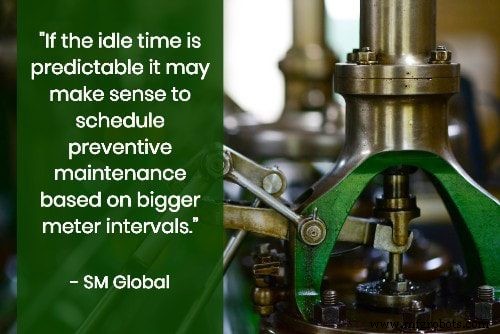
17. Pahami perbedaan antara waktu kerja dan waktu menganggur. “Anda dapat menjadwalkan pemeliharaan preventif berdasarkan pembacaan meter pada peralatan. Namun, meter peralatan biasanya tidak membedakan antara waktu kerja dan waktu idle. Jadi mesin yang menganggur selama 20% dari waktu mungkin memiliki jadwal pemeliharaan preventif lebih sering daripada yang diperlukan. Jika waktu idle dapat diprediksi, mungkin masuk akal untuk menjadwalkan pemeliharaan preventif berdasarkan interval meteran yang lebih besar.”— 7 Tips Merencanakan Pemeliharaan Pencegahan Peralatan, SM Global
18. Pastikan bahwa tugas pemeliharaan preventif Anda bermanfaat bagi peralatan Anda. “Melumasi rak dan pinion gergaji balok, misalnya, dapat menyebabkan gemuk dan debu gergaji mengeras di dalam roda gigi seiring waktu, yang pada akhirnya mencegahnya bergerak. Jika Anda tidak yakin tugas mana yang bermanfaat untuk setiap peralatan, tanyakan kepada perwakilan peralatan Anda.”— 10 Tips untuk Pemeliharaan Pencegahan, Mesin Stiles; @StilesMachinery
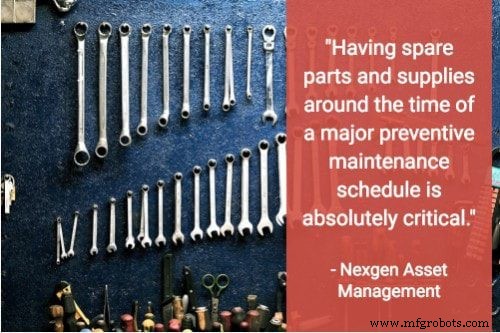
19. Mengantisipasi kebutuhan persediaan suku cadang di masa depan. “ Having spare parts and supplies around the time of a major preventive maintenance schedule is absolutely critical. Asset management software allows you to check the availability of the spare parts for dates when the work orders are due. This report can help you identify parts that are insufficient for the required work orders in the future. If you know which parts you are falling short on, you can order them in advance from suppliers rather than waiting till re-order limits are reached.”—7 Tips for Better Equipment Preventive Maintenance , Nexgen Asset Managment; Twitter:@nexgenam1
Workforce Management and Communication Tips
20. Use different methods of communication. “Appropriate repetition and reinforcement are necessary. The average person is bombarded with more than 300 messages while at work, and multiples of that outside of work, Finney says. Getting a message to land with an audience might take as many as 12 repetitions, in some cases, he says.”–John Finney as quoted in Facilities Maintenance Decisions Magazine, For Good Facility Management Communication, Keep Three Points in Mind; Twitter:@maintenance_mag
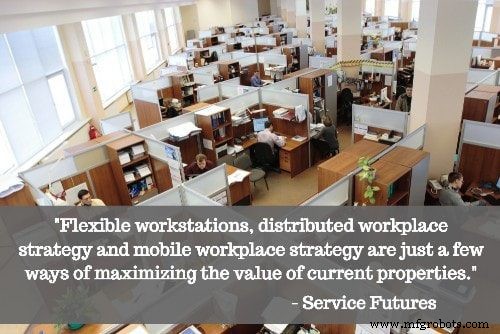
21. Optimize the use of available workspace. “Space costs money. Knowing that we are moving towards a working environment consisting of virtual or mobile workers, investing time in developing new workplace designs that can suit these new ways of working while increasing space utilization rates can result in impressive cost savings. Flexible workstations, distributed workplace strategy and mobile workplace strategy are just a few ways of maximizing the value of current properties. Reinvestment can with advantage be allocated to less space, but better space propositions.”—7 Ways to Grow Competitiveness in the Facility Management Industry by 2020 , Service Futures; Twitter:@issworld
22. Be the master of your company’s physical assets. While other managers may work to manage clients or staff, your job is to manage facilities and all that occurs in them. Your corporation’s physical assets are just as important as your human resources, and you are the expert in this field. Whether it’s collating data or contributing to the organization’s bottom line, your input is a valuable part of corporate decision-making. If you’d like to change buying practices or convert to more energy-efficient heating, make a statement and back it up with your data and your years of facilities management experience.–James McDonald, 5 Things Facilities Managers Must Do to Gain Respect &Clout, iOffice; Twitter:@iofficecorp
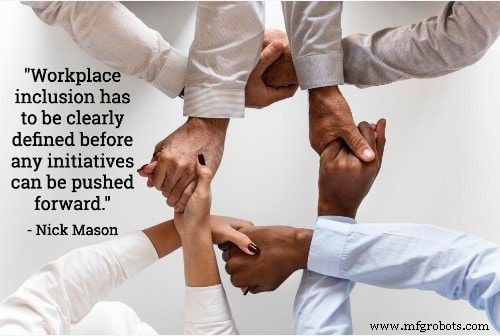
23. Set clear definitions for facilities work practices. “Workplace inclusion has to be clearly defined before any initiatives can be pushed forward. One useful definition of an inclusive office is a workplace in which all staff are treated with respect and have equal access to resources and opportunities. Facility managers should build on this high-level description to create an idea of what concepts like equal access, diversity and fairness look like in their own facilities. Including these definitions in your company’s core values will help you to set clear goals and build concrete policies.”–Nick Mason, A Facility Manager’s Guide to Inclusive Workplaces Office Space Software; Twitter: @OfficeSpaceSw
24. Use a design that plans for social time and spaces. “Let’s get together:when you’re designing your facilities, design social spaces for your employees. These might be lunch or break rooms, games rooms, gyms, or even community gardens. When you provide places where employees can relax and socialize in a less-structured atmosphere, you may find that new connections emerge between departments and between different levels of management.”–Tiffany Bloodworth Rivers, 7 Tips to Help Facilities Managers Make The Workplace A Stress Free Zone , iOffice; Twitter:@iOfficeCorp
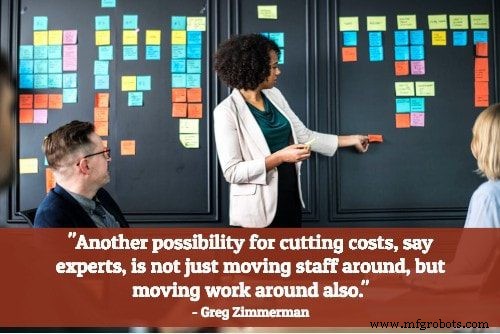
25. Consider moving some basic activities from outsourcing to in-tasking. “Another possibility for cutting costs, say experts, is not just moving staff around, but moving work around also. This means carefully examining all outsourcing contracts to see if they can be scaled back and the work completed by in-house staff. Bechtol says she’s actually been doing this for years — completing tasks like painting and cleaning with in-house staff and overtime — but it’s even more valuable now in tough economic times.”–Nancy Bechtol as quoted by Greg Zimmerman, Facilities Maintenance Decisions Magazine; Twitter:@maintenancemag
26. Create a formal in-house process for developing employee skills. ”We are focused on ‘building a bench’. This concept is broadly used to describe our attempt to formally identify in-house talent in many of our labor shops. We identify talent through a competitive selection process based on potential vs. skills and promote our selected personnel to the worker and helper level while training them to achieve appropriate full mechanic level with associated certifications/licenses.”–Robin Morey as quoted by Higher Ed Facilities Forum, Dealing with an Aging Facilities Management Workforce, Twitter:@HEFForum
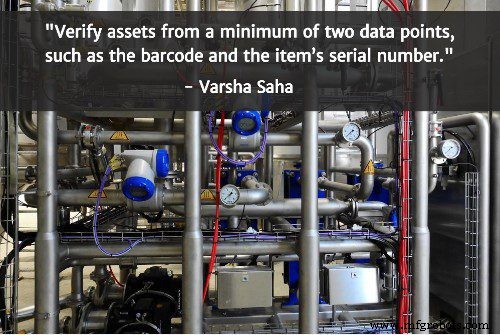
27. If outsourcing your FM, work with an agile partner who adapts to your needs. “This is one of the single biggest advantages that smaller providers have. They can allow their frontline staff to be creative and actually make changes to processes and implement them. This directly leads to the client receiving a more fit-for-purpose solution and ultimately receiving greater value which grows a greater relationship.”–Andrew Hulbert, as quoted by Kevin Stanley, The Art of Delegation, FMWorld; Twitter:@fm_world
28. Sell your department wisely during budget presentations. “We always present our budgets by leading with how the proposal responds to a real problem. In other words, there has to be a compelling reason based on our mission for why we would submit budgets for anything.” By presenting specific information on how and why you’ve chosen your budget numbers, you can help the C-suite see that your budget is well within reason.”–Tim Woodley, as quoted by David Spence, 5 Budgeting Tips for Facilities Managers , Office Space; Twitter:@officespacesw
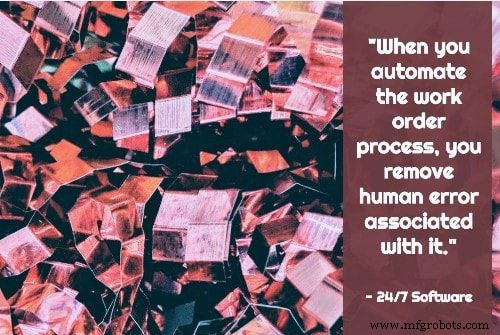
29. Automate the work order process. “When you automate the work order process, you remove human error associated with it. Essentially, you’re taking the people out of the process and ensuring nothing gets missed or overlooked. Doing this allows you to create, track, edit and automatically communicate work orders for your facility. This is number one on the list, because it’s one of our favorite habits – and arguably the most important! Don’t let problems with employees slow down your operation or increase workplace stress for others.”—The 7 Habits of Highly Effective Facility Managers, 24/7 Software; Twitter: @247_software
Tips for Leveraging Technology Tools, Software, and Metric
30. Utilize software to help facilities managers organize and access information.
“There are many different software options out there than can aid FMs in organizing and streamlining their everyday tasks. This ranges from software designed to help manage all maintenance activities to logging and tracking facility visitors for security purposes.
There are also several comprehensive facility management software options available. One popular option in this area is NetFacilities, a web-based software that aims to centralize the many things FMs need to manage—from vendors and work orders to asset management and preventative maintenance—in one convenient place.”–Neal Peters, Top Technology Tools for Facility Managers , DPM Care; Twitter:@dpmcare
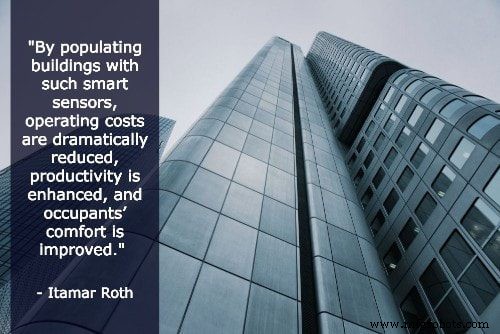
31. Utilize modern smart sensor solutions to reduce costs and enhance capabilities. “By populating buildings with such smart sensors, operating costs are dramatically reduced, productivity is enhanced, and occupants’ comfort is improved. Specifically, detailed information about occupants’ presence, location, count, and activity can now be used to significantly optimize facility management. Hot desking, meeting rooms booking, optimized space planning, and energy savings are some of the immediate use cases.”–Itamar Roth, Facility Management Is Facilitated By Smart Sensors, Facilities Executive ; Twitter:@facilityexec
32. Manage HVAC remotely using software tools. “One of the most exciting features of Facilities Management software is the ability to manage heating and cooling remotely, or set a programmable thermostat to move set temperatures up or down throughout the day. Facilities planners love the ability to analyze and explore energy use from heating and cooling systems. Leaders can use the ‘business intelligence’ delivered by the software to set thermostats and controls for maximum savings in energy costs. Some of these tools can even be ported to smartphones to help remote managers do their jobs from wherever they happen to be.”—10 Ways Software Can Help with Facilities Management , SelectHub; Twitter:@selecthub
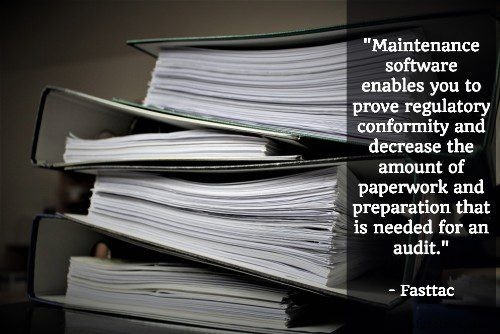
33. Use your software to double-check your compliance. “Maintenance and facilities administration systems must frequently abide by national and global regulatory requirements. All maintenance administrators face occasional random or audits inspections by regulatory authorities. Maintenance software enables you to prove regulatory conformity and decrease the amount of paperwork and preparation that is needed for an audit. Maintenance administrators can simply create reports showing the maintenance work done on essential machinery. This makes conformity traceable and minimizes the risk of non-compliance penalties.”—7 Steps to Successful Facilities Management , Fasttac; Twitter:@fasttac
34. Facilities management KPIs should highlight errors and opportunities. “KPIs allude to opportunities and errors in your company. Paired with the Internet of Things (IoT) and energy management systems, KPIs can be used to highlight missed maintenance tasks, greater traffic area of your business or problems with machinery. Take, for example, using a percentage KPI of planned maintenance against reactive maintenance. In other words, is preventative maintenance saving more money than repairing equipment when it fails?”—7 Tips for Creating Facilities Management KPIs , Entouch Controls
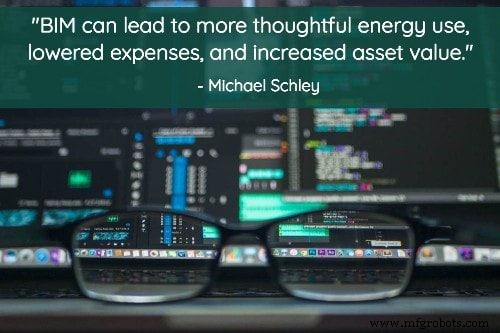
35. Use building information monitoring to monitor system performance. “Closely monitoring energy and water use to reduce building-operating costs is another benefit. By allowing owners to monitor and analyze the performance of multiple systems—air-conditioning levels, lights on automatic dimmers, water usage—BIM can lead to more thoughtful energy use, lowered expenses, and increased asset value.”–Michael Schley as told by Jeff Link, BIM for Facilities Management:4 Tips to Improve Lifecycle Performance and Reduce Costs , Autodesk; Twitter:@autodesk
36. Consider advanced automated building entry solutions. “A feature that’s gaining a lot of ground is using facial recognition technology to let people in and out of the building. It’s more secure than key fobs or cards, and unlike cards and fobs, you can’t forget your face at home. It’s like batting a triple, or killing three birds with one stone. Automated building entry removes the need to grant special access to the building, replace missing key fobs or cards, or issue new ones to new employees.”–Michael Moulton, 5 Tech Features Facilities Managers Can’t Live Without , Teem
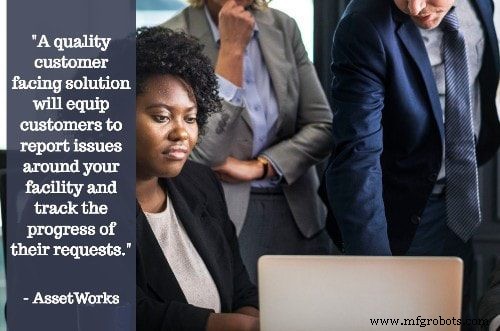
37. Provide a customer facing software solution for reporting improvements and tracking requests. “Offering simple solutions for your customers will keep them happy – and your buildings running smoothly. A quality customer facing solution will equip customers to report issues around your facility and track the progress of their requests. Not only does a customer portal help your clients feel heard as you keep them up to date on progress. A digital customer request system simplifies the work order and assignment process for your facilities management team as well.”—Top Facilities Management Tips for Long-Term Success , AssetWorks; Twitter:@AssetWorks
38. Thermal imaging technology can help identify and fix unseen problems. “ Performing facility maintenance and engineering tasks is like sailing among icebergs. What technicians can’t see will sink them — or their facilities. Thermal imaging technology gives technicians the ability to see the unseen, making it easier to spot failing motors and electrical components, HVAC condensate leaks, bad ductwork, and leaky roofs. Technicians then can fix problems before they become large headaches, as well as reduce heating and cooling costs as part of sustainability initiatives.”–John Anderson, Putting Thermal Imaging to Work in Facility Maintenance, FacilitiesNet
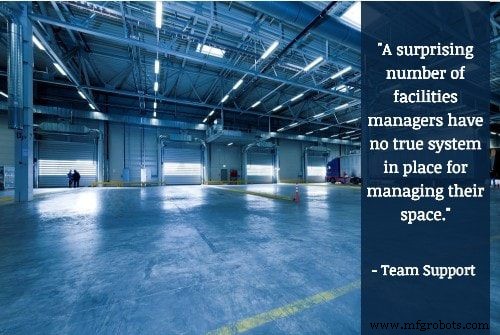
39. Integrate a facilities management software system. “A surprising number of facilities managers have no true system in place for managing their space. More than a quarter of everyone interviewed – 28 percent – say they currently do not use any type of facilities management system. A further 23 percent of participants use pen and paper methods for their facilities management. While this is slightly better than no system at all, it still makes it very difficult to collect data, keep accurate records, or gain much insight from the information they have.”—The Importance of Facilities Management Systems , Team Support; Twitter:@teamsupport
40. Leverage your software system to make EH&S benchmarks transparent. “Facilities Management software is specially designed to help make health and safety benchmarks and outcomes transparent. It may help significantly with compliance with various industry standards, such as HIPAA in the healthcare industry and Sarbanes-Oxley in the financial field. It can help to document best practices for avoiding accidents, or in the worst case scenario, document the facts around a workplace accident. Various types of health and safety features can save a lot of time and effort for busy management teams, and help the company to benefit from a better reputation.”—10 Ways Software Can Help with Facilities Management, Select Hub; Twitter: @selecthub
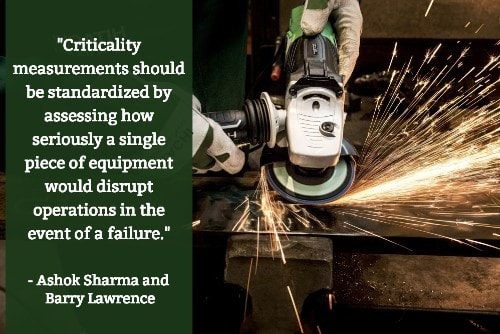
41. Have an equipment criticality matrix to prioritize work. “This method identifies how critical a piece of equipment or maintenance task is to your business and will ultimately show you where it should land in your prioritization process. Criticality measurements should be standardized by assessing how seriously a single piece of equipment would disrupt operations in the event of a failure. “–Ashok Sharma and Barry Lawrence, 5 Essential Tools for Facilities Managers , eLearning Industry; Twitter:@elearnindustry
42. Smartsheet software can add unique collaboration features to everyday spreadsheet use. “Smartsheet is a spreadsheet that you share with your co-workers, but its features go far beyond Excel. This tool combines the traditional spreadsheet with project management tools, templates, and forms and allows you and your colleagues to access spreadsheets on mobile devices and work on them collaboratively.”–Tiffany Bloodworth Rivers, 9 Easy-To-Use Tools That Will Help Any Facilities Team Collaborate, iOffice; Twitter:@iOfficeCorp
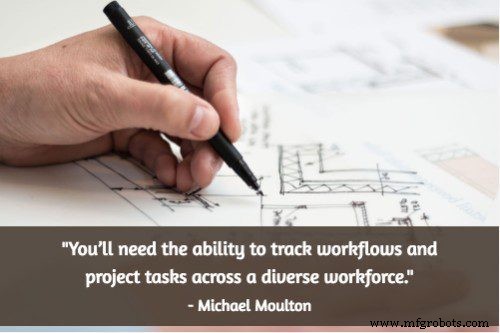
43. Adaptive workflow tracking allows you to track activity throughout a diverse workforce. “The business world is increasingly embracing a larger remote workforce. Offices are used as areas to collaborate, develop, and design new ideas. The day-to-day work can be, and often is, done from home. That means you’ll need the ability to track workflows and project tasks across a diverse workforce. Emailing details back and forth regarding a project gets hectic, and it’s easy to lose an important piece of a proposal to your inbox.
Again, we’ll turn to automation – adaptive workflow tracking software that shows real-time project progress via a cloud-based platform will be the norm in a few short years. Products such as Trello or Asana are great examples of adaptive workflow tracking integrating with high success into businesses of all sizes.”–Michael Moulton, 5 Tech Features Facilities Managers Can’t Live Without, Teem
Inventory and Asset Management Tips
44. Keep your facilities management documents consistent and accurate. “ If you’re a responsible facilities manager, you have to know what you’re responsible for. You cannot do your job properly without the correct information. If you don’t have proper records on the state of your facilities, you can’t do your job as a facilities manager. Without accurate documentation, you can’t even get a good bid from a vendor for work on your building. The first thing they will ask is, Where are the As-Built drawings? Without the As-Builts, the bid could be much higher.”—7 Tips on Reducing Facilities Maintenance Costs and Risks, SKYSITE; Twitter:@skysiteproject

45. Implement a consistent asset tagging process. “ Verify assets from a minimum of two data points, such as the barcode and the item’s serial number. When disposing of assets, this step is crucial to ensure an “accurate and verifiable chain of custody,” which can help to mitigate data breaches (particularly for the disposal of IT assets) and also help to maintain compliance with regulations.
“Implementing a consistent asset tagging process flow ensures that all assets received by your company are consistently classified and tracked, making it easy to locate assets throughout the company, implement regular maintenance schedules, and maintain accurate record-keeping for auditing and accounting purposes. Developing clear policies and procedures and training your team members on approved asset tagging procedures streamlines processes and can ultimately have a positive impact on your bottom line, allowing you to improve resource utilization, reduce unnecessary duplication of assets, and get more usable life out of your investments.”–Varsha Saha, 6 Steps in Asset Tagging Process Flow , Kode Kamera; Twitter:@camcode
46. Keep assets updated and clearly define essential vs. non-essential assets. “After collecting data and developing a maintenance schedule for your assets, you need to plan for the long-term maintenance of your asset inventory. Specifically, put a plan in place that revolves around updating and decommissioning assets. In some cases, you may find that a particular asset, even if updated, isn’t serving your organization in the best way, making it a non-essential asset that you don’t need to continue holding. Similarly, by having a working inventory list and accompanying data, dealing with critical needs and unexpected asset failures will be easier because you know exactly what needs to be done and when it needs to take place.”–Luke Perkerwicz, The Beginners’ Guide to Facility Asset Management , AkitaBox; Twitter:@Akitabox
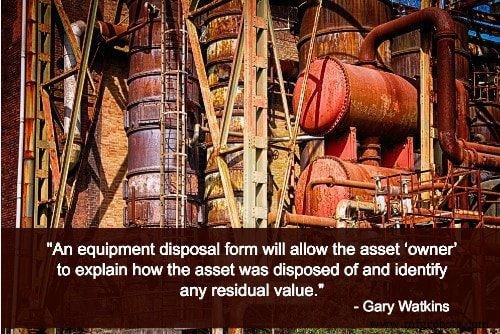
47. Track and dispose of decommissioned assets. “ However good asset management and maintenance planning is, there comes a time when an asset reaches the end of its useful life and should be disposed of. On a practical level, all assets disposed of must be recorded on the asset register/software, to ensure they are not included as part of the organization’s portfolio. An equipment disposal form will allow the asset ‘owner’ to explain how the asset was disposed of and identify any residual value.”–Gary Watkins, Effective Asset Management for Facilities Managers, Service Works; Twitter:@service_works
48. Do an asset assessment and document those conditions. “If you’re trying to get a handle of your documents, the first thing you should do is an asset assessment. Detail the condition of all the main equipment and systems, and document those conditions. No technology can help you unless you document what you have. After the assessment, you should create and begin a proactive maintenance program, as well as an equipment replacement plan—that should be a 3-year to 5-year plan. Even if the piece of equipment is 30 years old, you need to know when you need to replace it.”—7 Tips on Reducing Facilities Maintenance Costs and Risk, SKYSITE; Twitter:@skysiteproject
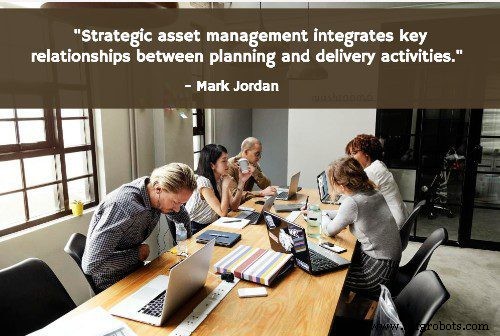
49. Consider a strategic asset management approach. “Strategic asset management integrates key relationships between planning and delivery activities. The framework that underpins the decision-making process of those activities is key, as it allows informed decisions and correlation between strategic goals and delivery outcomes. It also acts as the integration mechanism between a singular project and an organization’s wider portfolio of projects.”–Mark Jordan, An Asset Management Approach to Facilities Management , FM Magazine; Twitter:@FMmagazine_au
50. Maximize vertical space in your warehouse. “ Sebuah gudang memiliki sejumlah rekaman persegi untuk digunakan, membuat tata letak yang inovatif dan dioptimalkan menarik bagi manajer gudang saat ini yang dihadapkan dengan penyimpanan volume produk yang meningkat dalam jumlah ruang yang statis. Pada tahun 2016, pertimbangkan untuk memanfaatkan ruang vertikal dengan lebih baik di fasilitas Anda, tetapi jangan abaikan praktik terbaik pengoptimalan tata letak. Maximize your use of vertical cubic footage by placing seasonal products or those that move less frequently in harder-to-reach vertical storage areas.”–Varsha Saha, 6 Tips for Better Warehouse Inventory Management in 2017 , Kode Kamera; Twitter:@Camcode
Products and Tracking Solutions from Camcode:
- Magnetic Warehouse Labels
- Vinyl Labels
- Property Of Stickers
- Custom Barcode Labels
- Tag Properti
- Label Keamanan
- Pipe Markers
- Label UID
- Permanent Labels for Equipment
- Pallet Labels



























